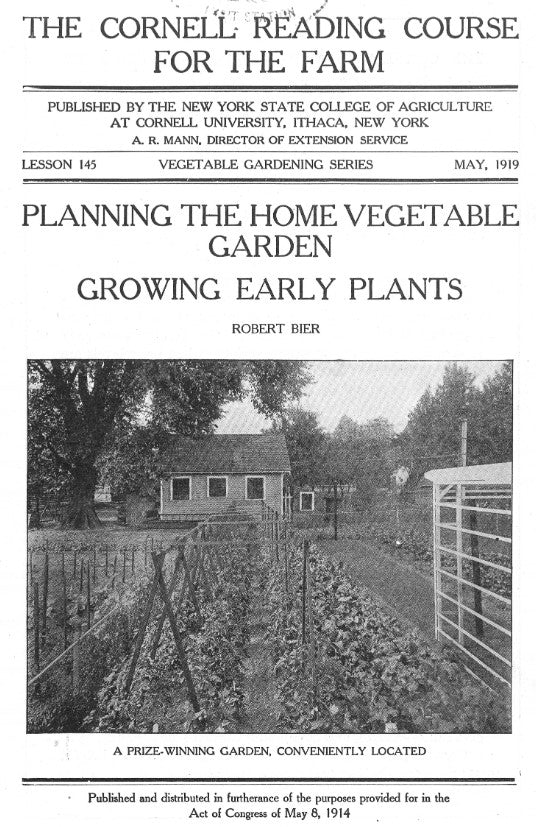Great Lakes Staple Seeds
Skills (1919) Planning the Home Vegetable Garden Growing Early Plants
Skills (1919) Planning the Home Vegetable Garden Growing Early Plants
Couldn't load pickup availability
The Cornell Reading Course for the Farm Lesson 145 Vegetable Gardening Series by Robert Bier; May, 1919
"Planning a Subsistence Homestead," authored by Walter W. Wilcox, is a comprehensive guide designed to assist families in achieving self-sufficiency through part-time farming and small-scale livestock management. The publication, issued as a Farmers' Bulletin by the U.S. Department of Agriculture, covers various aspects of subsistence farming, providing practical advice and detailed plans to help families grow their own food and reduce living costs.
Renewal of Interest
The bulletin begins by addressing the renewed interest in subsistence farming due to economic hardships and government policies. It highlights the benefits of combining part-time farming with outside wage work to provide families with both cash income and home-grown food. This approach, often called subsistence farming, is particularly attractive to families with limited incomes and several children, offering a way to ensure a steady supply of fresh fruits and vegetables.
Selecting Land Near Cities
Selecting suitable land is crucial for the success of a subsistence homestead. The bulletin emphasizes the importance of choosing productive, well-drained soil near employment opportunities. Key considerations include the distance to work, availability of pure water, and proximity to community amenities like schools and roads. The quality of the soil should take precedence over the state of existing buildings when purchasing land.
Vegetable, Poultry, and Fruit Production
Wilcox provides detailed plans for vegetable gardens in different regions of the United States. These plans suggest the types and quantities of vegetables and fruits to plant, ensuring a continuous supply throughout the growing season and ample produce for canning and storage. A small poultry flock and a few fruit trees are recommended to complement the garden produce.
Layout for a Small Acreage
Illustrative plans for using approximately one acre of land efficiently are provided. The plans vary for northern and southern states, taking into account regional differences in climate and soil quality. The layout emphasizes placing high-maintenance crops closer to the house to reduce labor and organizing the land to facilitate easy cultivation.
Cash Expenses and Returns
The bulletin outlines the estimated cash expenses for establishing and maintaining a subsistence homestead, including costs for plowing, seeds, fertilizers, and chicken feed. It also provides an estimate of the potential returns from the homestead, emphasizing that the savings from home-grown food can significantly offset the initial investments.
Winter Vegetable and Fruit Supply
To ensure an adequate food supply during the winter months, Wilcox discusses methods for storing, drying, and canning surplus produce. Detailed canning budgets for families in different regions are provided, suggesting the quantities of various foods needed to sustain a family of five during the non-productive months.
Feed and Livestock Production
The bulletin explores the integration of livestock into the subsistence homestead. It suggests keeping poultry, a cow or two, and pigs, and provides guidelines for raising the necessary feed. The space and resources required to maintain these animals are discussed, along with the benefits of producing milk, butter, and meat at home.
Limitations and Practical Considerations
Wilcox cautions against overestimating the savings and underestimating the labor involved in subsistence farming. He emphasizes the importance of realistic expectations and the need for additional income to meet non-food expenses. The bulletin also discusses the challenges of farming on poor-quality land and the importance of thorough investigation before purchasing property.
Possibilities of a Small Wood Lot
Having a small wood lot can significantly reduce heating costs, especially in rural homes without access to gas or electricity. Wilcox advises careful management of timber resources to ensure a sustainable supply of firewood.
Conclusion
"Planning a Subsistence Homestead" is a valuable resource for families looking to combine part-time farming with wage work to achieve a degree of self-sufficiency. The bulletin provides practical advice on land selection, garden layout, livestock management, and food preservation, offering a realistic perspective on the benefits and challenges of subsistence farming.
This detailed guide serves as an essential tool for those interested in reducing living costs and increasing food security through small-scale, sustainable farming practices.

